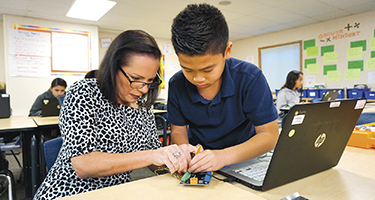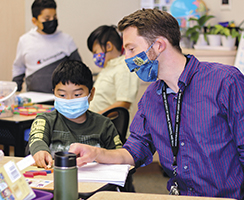
Closing the Relationship and Trust Divides
How one school system has expanded its 1:1 connections from technology to personal support
BY SUSAN A. ENFIELD/School Administrator, February 2022
 |
| Susan Enfield, superintendent of Highline Public Schools in Burien, Wash., pledges district staff will get to know every student by name, strength and need. PHOTO COURTESY OF HIGHLINE PUBLIC SCHOOLS IN BURIEN, WASH. |
Highline Public Schools, a richly diverse school system serving over 17,500 students just south of Seattle, Wash., is guided by our promise to know every student by name, strength and need, so they graduate prepared for the future they choose.
It’s more than a tagline. This promise is the DNA of our system, connecting us to one another through a shared purpose. While the pandemic may have physically disconnected us from one another for a time, it also amplified our need for human, in-person connection in a very powerful way.
Bridging Divides
Prior to March 2020, we knew we had a digital divide that prevented too many of our students from accessing their learning from home. Once the decision was made to close schools, we scrambled as a district and community to strategically deploy over 13,000 devices to those students who did not have a reliable device at home. Suddenly, after years of debating the pros and cons of a 1:1 device initiative, we found ourselves having to do it in the moment in order for our students to attend school from home — and remain connected to one another.
Without home broadband access, however, our students could not connect with their teachers and classmates and remain part of their school community, albeit remotely. Thanks to our incredibly dedicated and talented Highline staff and community, we have been largely successful in bridging our digital divide through fundraising and partnerships while also raising awareness of the need to ensure that every student has the technology they need to succeed.
A few examples of how our efforts are paying off:
»In November 2020, we successfully passed the first technology levy ($32 million) in the district’s history with an approval of more than 73 percent;
»In our family survey last spring, more than 95 percent of those who responded said they now had reliable home broadband access; and
»In recent months, I received an unprecedented number of family e-mails in Spanish and Vietnamese, our two most common languages after English, indicating more of our families now have the technology to connect with us.
The Relationship Divide
In addition to barriers caused by the digital divide, we also recognized early on that we had another divide preventing students from remaining connected to their school community: a relationship divide. Despite committing to our Highline promise through the hard work of so many staff, we knew not all of our students had a meaningful connection with an adult in their school. So at the same time as we launched a 1:1 device initiative, we launched a 1:1 student-staff connection effort.
As a former high school teacher, I know firsthand it takes only one adult to help a student stay connected and on track. Research bears this out. Education Week reported in March 2019 that an analysis of 46 educational research studies found “strong teacher-student relationships were associated in both the short- and long-term with improvements on practically every measure schools care about.”
We always have had many students in Highline who could name one or more adults in their school who know them by name, strength and need — and I am grateful to our dedicated staff who make this happen. The hard reality, however, is that still too many students do not have that meaningful and essential relationship with an adult at school. Realizing we could no longer leave this to chance, I challenged a team of central-office and building leaders to develop a 1:1 connection strategy for our schools.
We asked our principals and school teams to ensure and track that every student had a weekly Zoom meeting or call with a staff member who would commit to checking in on the student and either building a new relationship or strengthening an existing connection.
One elementary principal described the initial response and the ongoing impact this way:
“While the idea of making time for 1:1 connections with students felt like a daunting task prior to doing it, once we began the connection meetings, many staff members shared they became the highlight of their day! Staff members shared how much they enjoyed getting to know students in ways beyond what was possible during classroom interactions and how their relationships deepened with students over the course of the year. Families also reported feeling the connections were very meaningful and impactful for their children. Many shared their students would eagerly look forward to the Zoom meetings or phone calls with their staff member and grew to count on that special time during a period when their students felt rather disconnected from their school community.”
Indeed it has not been easy, and we have learned important lessons along the way. For example, initially we asked that every student in prekindergarten through 12th grade receive a weekly check-in, without differentiating for those who may need more or less. Some families indicated they were hearing from staff at their child’s school too often — a good problem to have in my view.
 |
| Andreas Haugen is an elementary teacher in the Highline Public Schools in Burien, Wash., which is freeing up time for teachers to build connections with individual students. PHOTO COURTESY OF HIGHLINE PUBLIC SCHOOLS IN BURIEN, WASH. |
Knowing how hard our staff work and wanting them to use their time strategically and in ways that most benefit students, last spring we adjusted our plan. We now take a tiered approach and ask schools to identify those students who require more frequent contact than others and schedule those connections based on individual students’ needs.
We will continue to learn and adapt, but we will not go back to allowing any of our students to be invisible in our schools.
The Trust Divide
This year, we are asking our staff in schools to continue these connections, but rather than mandate expectations, we instead are trusting our staff to do this in the way that works best for their school community. Trust matters mightily within an organization, and it is important that our staff know we trust they are doing everything in their power to keep our students connected.
Research supports building trust within schools and between schools and central-office staff and families. (My go-to sources are
Trust in Schools: A Core Resource for School Reform by Anthony Bryk and Barbara Schneider and
Trust Matters: Leadership for Successful Schools by Megan Tschannen-Moran.)
Building trust, however, must extend beyond words to actions. So we also are putting the conditions and supports in place to help staff do this work. We paid teachers and staff members for extra time to make family connections before the start of school last year. And this school year we designated last Sept. 13 as our first-ever Family Engagement Day. Rather than teach classes, teachers and other school staff spent time connecting with families to learn about their students and establish relationships.
Additionally, recognizing that managing COVID in our schools continues to demand significant time and energy from our staff, we also encourage principals to suspend certain meetings to provide teachers with time to connect. We have worked with our teacher association to extend deadlines for forming school committees. If we want our school staff to make time for building relationships with students, we must support time for them to do that.
Ongoing Duty
As district leaders we have a responsibility to care for our staff so they can care for one another and their students. Connection matters in times of crisis, but we should never forget that once the crisis subsides, our commitment to ensuring all students are known by name, strength and need must remain as strong as ever.
We have seen what is possible when we choose or are compelled to no longer ignore the realities facing our students and families. It is now time for us to move from reacting to acting on the permanent changes needed to make our education system one that is truly equitable, so that every child has an equal share in the promise of public education.
SUSAN ENFIELD is superintendent of the Highline Public Schools in Burien, Wash. Twitter:
@SuptEnfield